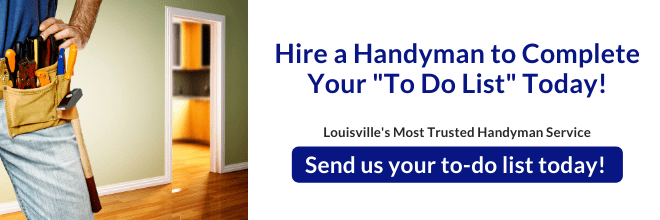The Complete Handyman Guide to Preparing Your Home for Spring
- 30 Mar, 2022
- •
- 0 Comments
Spring is on the horizon. The days are getting longer, the sun warmer, and you’re itching to get back outside. Before you can fully enjoy spring’s bounty, however, there’s likely some seasonal home care you need to attend to. After all, harsh winters can do a number on your home, especially on exterior features like your windows, deck, gutters, and landscaping. While you’re getting ready for spring to arrive in full force, take this time to assess any damage that accrued over the past few months and invest in a little spring cleaning.
 Not sure where to start? Louisville Handyman’s team of industry professionals has been providing superior home-building and maintenance services in Louisville for 20 years (just ask our customers!); and, over the years, we’ve learned a thing or two about how to prepare for spring. Performing this maintenance on a yearly basis helps protect the value of your property, not to mention making it more comfortable and enjoyable for your family to use. Take advantage of the longer days and warmer weather to tackle some of the chores on this spring home maintenance checklist:
Not sure where to start? Louisville Handyman’s team of industry professionals has been providing superior home-building and maintenance services in Louisville for 20 years (just ask our customers!); and, over the years, we’ve learned a thing or two about how to prepare for spring. Performing this maintenance on a yearly basis helps protect the value of your property, not to mention making it more comfortable and enjoyable for your family to use. Take advantage of the longer days and warmer weather to tackle some of the chores on this spring home maintenance checklist:
Getting Ready for Spring in Louisville
1. Clean the Gutters
Winter storms have a knack for blowing leaves and other debris into your gutters. While this may not seem like a huge deal, clogged gutters can end up causing water to leak, damaging your roof, foundation, or the interior of your home. You can remove a majority of the debris by hand — be sure to wear protective gloves — and then hose down the system. Make sure your gutters are working properly and that the downspouts are channeling water at least five feet from your home’s foundation walls.
You should also take a moment to check if you see any places where the gutter has come loose from your roof. If you do, your gutter needs new fasteners and it may be wise to seek the help of a professional. Working with a professional for significant repairs means you can feel confident that your repairs will last with rain-or-shine gutters. Plus, you can take the opportunity to pick their brain about when you should clean your gutters next, what’s the best time of year to clean your gutters, and any other questions you may have.
While you’re inspecting the exterior of your home, here’s another of our spring plumbing tips: test your water pressure and check your exterior faucets for damage caused by winter freezing.
2. Inspect for Roof Damage
The excessive snow, rain, and wind associated with winter have a tendency to cause some damage to your roofing system. As the weather grows warmer, do a full inspection of your roof and see if there are repairs to be made. If there is severe damage or your roof is more than 20 years old, you may need to schedule a roof replacement. You should also take a moment to clean off debris that’s built up over time. Although there’s no definitive best time of year to get your roof cleaned, you should perform this routine home maintenance task when temperatures are above freezing.
3. Wash and Repair Windows
Like regularly cleaning your roof, window spring maintenance is essential to keeping your home in good condition. Check for water damage and rot, recaulk the windows if need be, and swap out any warped or damaged screens before washing the inside and outside of your windows.
4. Tune-up Your AC
It’s a good idea to inspect your air conditioning system and make necessary repairs during the spring before you actually need to use your AC. Inspect the unit’s panels to make sure they are still properly secured and clear away any debris such as leaves and twigs. Then replace the air filter before you turn on your home’s AC for the season. You can do most of these simple tasks on your own, but if you notice indicators of a larger problem, call in a professional.
5. Take Care of Landscaping
At the start of spring, you want to get your yard back in shape and ready for the growing season. Start by raking away branches, leaves, and other clutter on your lawn and then prune or trim your trees and shrubs. Aerate your lawn using a soil conditioner to help ensure the grass grows thick, even, and lush. If there are bare or damaged parts of the yard, reseed them. And, if you’re into growing your own food, you may want to do winter garden preparation for spring such as prepping the soil in your garden, flower beds, and planters as well as planning what you’ll plant.
6. Clean Your Foundation Vents
If your home has a crawl space, you may have vents along the foundation walls and many homes also have eave vents near the roof. When these vents collect leaves and other debris during the fall and winter, air can’t circulate properly and mold buildup may occur. Take a few hours to clean both your foundation and eave vents so they can function right. First, remove obstructions, then wash and vacuum the vents. Check for any damage and take care of any repairs.
7. Prep Your Outdoor Living Area
It’s time to dust off your outdoor furniture and get it set back up for the spring. Clean off your grill and other outdoor kitchen appliances and hose down any canopies or overhead coverings in your backyard. You should also tend to your outdoor living space (i.e. a deck, patio, or porch) by fixing loose boards, repainting or staining, filling cracks, and tending to any other repairs you find.
Sprucing Up Your Louisville Home
Spring cleaning is more than just another couple of tasks on your to-do list. It’s an important part of investing in your home and giving it the long-term care it needs to function properly for you and your family. Whether your to-do list involves simple cleanup and maintenance or a major renovation, Louisville Handyman & Remodeling can help. We offer a range of useful handyman services to assist busy homeowners, as well as the expertise to create beautiful living spaces that your family can enjoy for years to come.








